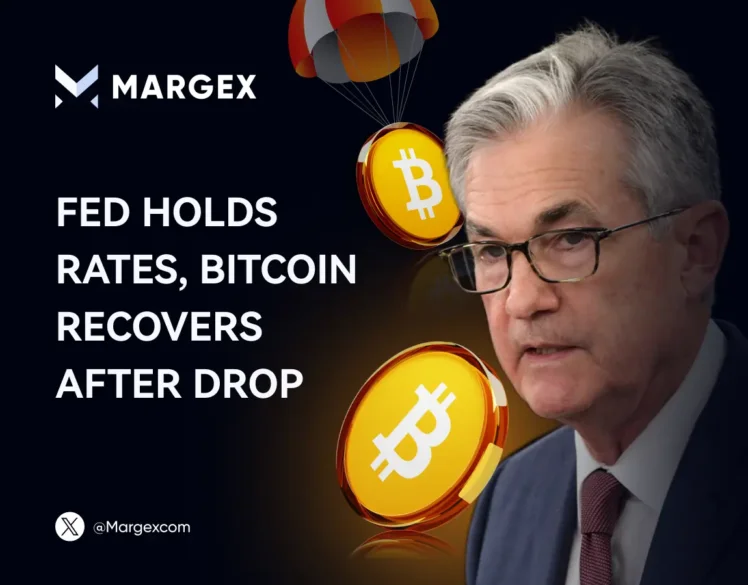Fed Reserve Leaves Rates Unchanged, Bitcoin Shows Resilience After Sharp Drop

Earlier this week, the chairman of the US Federal Reserve, Jerome Powell, gave his regular speech, which contained the Fed Reserve decision on interest rates. On Wednesday, as traders waited for the announcement, the markets reacted by plummeting. So did Bitcoin, dropping by 2.22% on Wednesday and falling from $85,100 to the $83,290 level. BTC printed a single red candlestick on an hourly chart, but it was a massive one.
Fed Reserve announces rate decision
However, even though the Fed Reserve did not resume its hawkish stance, it did not take to the dovish path either. Powell announced that this time the US central bank will maintain the current level of interest rates at 4.25% – 4.50%. This decision reflects the Fed’s interest rate to achieve economic stability, since the central bank tries to prevent even the slightest inflation rise if rates are reduced too early.
The Fed’s decision comes as the global economic environment is facing various challenges, which include the current trade tensions, geopolitical tensions and uncertainties. Powell acknowledged that even though inflation has been showing signs of slowing down, it was still far from the 2% target. Therefore, the Fed Reserve chose to avoid lowering rates for now and focus on achieving price stability.
Bitcoin quickly rebounds after Wednesday’s drop
The markets immediately responded to Powell’s announcement with a rise. Despite the understanding that the higher rates environment is going to hold for a while, Bitcoin rebounded after its 2.22% decline and went up by almost 2%, trading at $85,000 at the moment. Thus, Bitcoin has once again displayed resilience as the market began to adjust to the Fed chairman’s statement.
However, Bitcoin’s opponent and the traditional safe haven gold, has surged to reach a new historic price level over the past three days. Gold futures reached an all-time high of $3,350 per ounce after the largest chip producer, Nvidia, announced that its profits are likely to shrink by $5 billion due to the trade war between the US and Chinese economies.
The company’s shares tumbled 3% on that news. The same happened to the stocks of the leading tech companies, which are part of the Dow Jones Industrial Average. Analysts from the Bank of America now expect that the trade tensions with China are likely to affect AI-levered computing, networking, and optical stocks (AVGO, AMD, MU, ARM, MRVL, COHR, LITE).
US president lambasts Fed Reserve’s decision
The US president Donald Trump quickly reacted to Jerome Powell’s announcement. Taking to his social media network, Truth Social, he rebuked Jerome Powell for this move, saying that he should have brought interest rates down. In his post, Trump said that inflation was on decline now, citing a drop in prices for basic goods, food products, including eggs, and pointed out that inflation has stopped being a major concern for now. The main reason for this, per him, is that the US is getting rich on the trade tariffs with China.
He criticized Powell for preferring to maintain interest rates at the current level, while the European Central Bank has cut rates for the seventh consecutive time. Trump believes that the US is now lagging behind Europe in terms of monetary policy adjustments, adding that by doing so, the Fed might slow down the economic recovery of the US. His post also says, “Powell’s termination cannot come fast enough,” suggesting he wants the Fed chairman replaced by someone more agreeable. The aforementioned tariffs imposed on all Chinese goods now stand at 145%. China has responded with identical measures, as it is prepared to protect its economic interests.
Trump’s reaction aligns with his long-standing position on the US monetary policy. During his first presidential term, he repeatedly urged the Fed Reserve to implement lower interest rates, arguing that easier monetary conditions in the US would help the economy grow and create more jobs. Meanwhile, Jerome Powell remains in the opposite camp of economists who prefer a cautious approach and believe it is crucial to keep inflation under control before beginning to cut interest rates further.
Economic turmoil keeps markets tense
However, the broader economic uncertainty started with Trump imposing tariffs on countries across the globe. The first round of tariffs was meant to take effect in early March against Mexico, Canada, and China. For China, it was then 10%, which immediately went into power. For the other two, Trump delayed the trade fees for one month.
The second portion of tariffs was announced at the beginning of April, and this time, Trump decided to impose them on the whole world and raise the tariff line for China since they responded identically. Now, as mentioned above, Chinese companies have to pay tariffs of 145% when bringing goods into the US. China has copied that figure, enforcing it on US companies. But Trump says that he and Xi Jinping are friends, expecting this stand not to last long. The stock markets and Bitcoin plunged as investors began fleeing into gold.
As for the rest of the world, governments began to approach Trump with suggestions to “make a deal,” as he put it. Ultimately, he made a decision to postpone the draconian tariffs for 90 days.
Currently, the level of economic uncertainty in the world remains high. Investors and traders are watching the news, carefully planning every next step they make in the markets.


